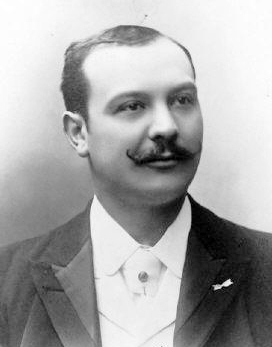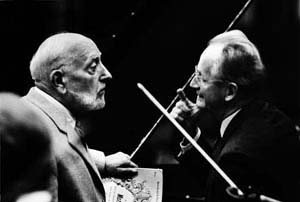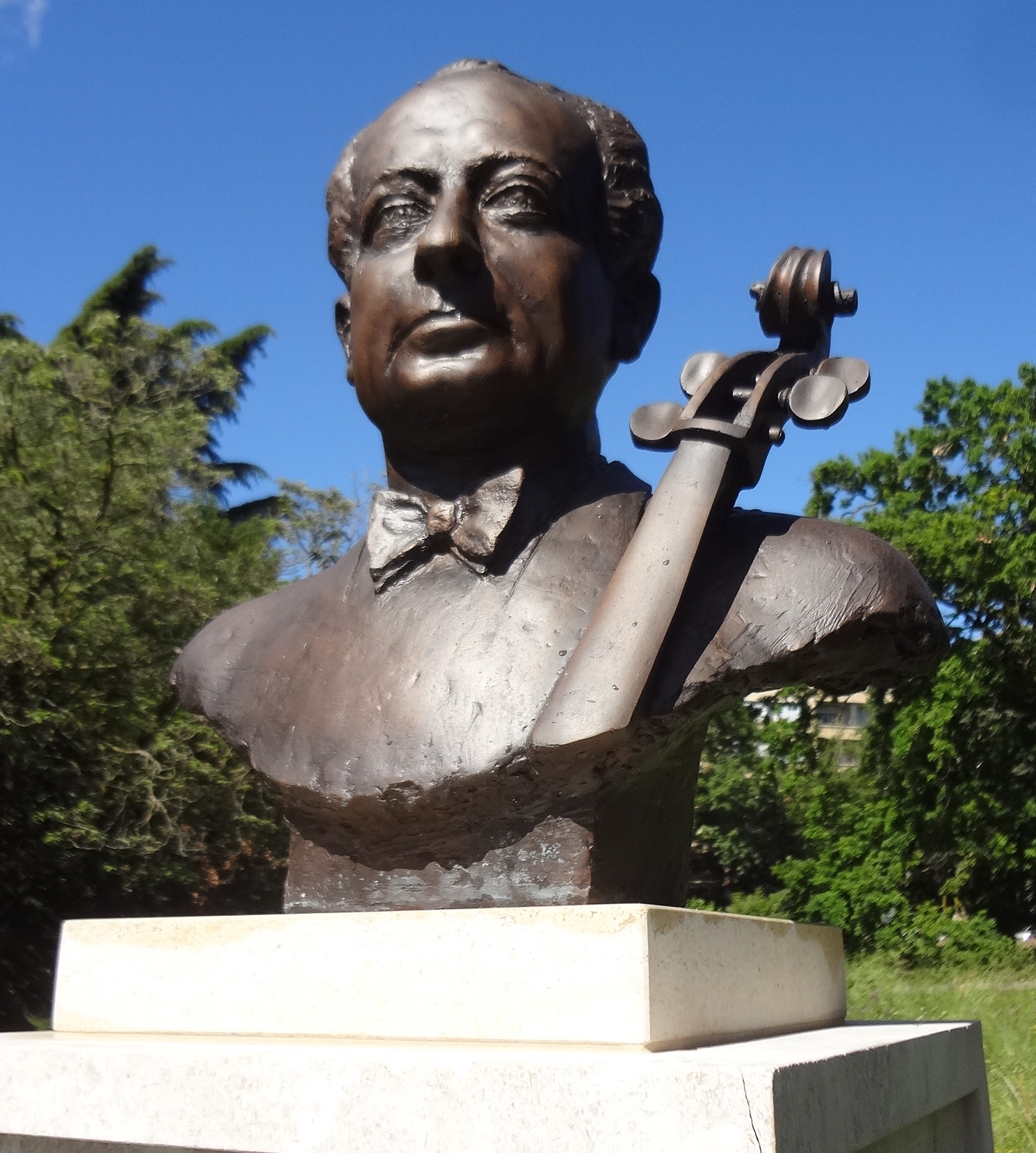1. Overview
Pierre Léon Marie Fournier (Pierre Léon Marie FournierPierre Léon Marie FournierFrench, 24 June 1906 - 8 January 1986) was a highly acclaimed French cellist, widely celebrated for his elegant musicianship, majestic sound, and warm expression. Often referred to as the "aristocrat of cellists" or "Prince of the Cello," he was a prominent figure in classical music throughout the 20th century, excelling both as a soloist and a chamber musician. Despite a childhood battle with polio that led him to switch from piano to cello, Fournier developed a virtuoso technique and a broad repertoire spanning classical, romantic, and contemporary works. His career, marked by extensive international tours and significant recordings, was briefly overshadowed by controversy regarding his performances during the Nazi occupation of France during World War II. Nevertheless, his profound artistry and pedagogical contributions left a lasting legacy on the cello world.
2. Biography
Pierre Fournier's life was a journey from a childhood illness to becoming one of the most revered cellists of his time, marked by significant musical achievements and a brief period of controversy.
2.1. Early Life and Education
Pierre Léon Marie Fournier was born in Paris, France, on June 24, 1906. His family had a strong artistic and military background; his grandfather was a sculptor, and his father served as a general in the French Army and even as the governor of Corsica. His mother, a talented pianist, introduced him to music and began teaching him the piano. However, at the age of nine, Fournier contracted a mild case of polio, which resulted in a loss of dexterity in his feet and legs. This physical challenge made it difficult for him to operate the piano pedals, leading him to switch to the cello.
At the age of 12, Fournier enrolled at the Paris Conservatory, where he received early training from Odette Krettly. He continued his studies under the tutelage of renowned cellists André Hekking and Paul Bazelaire. During his formative years, he also sought and received advice from the legendary Spanish cellist Pablo Casals. Fournier graduated from the Paris Conservatory in 1923 at the remarkably young age of 17, earning a first prize. His exceptional talent was immediately recognized, and he was hailed as "the cellist of the future," drawing praise for his virtuosity and distinctive bowing technique. Following his graduation, he continued to refine his skills under Bazelaire's guidance.

2.2. Early Career and International Performances
Fournier made his official debut in Paris in 1924, immediately establishing himself as a significant talent. From 1925 to 1929, he was a member of the Krettly Quartet, led by Robert Krettly, the brother of his early teacher Odette Krettly. His reputation grew rapidly when he performed with the Concerts Colonne Orchestra in 1925. By 1927, he was invited to be a soloist with the Concerts Colonne Orchestra, marking the beginning of his extensive touring career across France and various European countries.
His international prominence was further solidified in 1934 when he achieved great success performing with the Berlin Philharmonic. After World War II, his career expanded even further, leading to his highly anticipated American debut in 1948. This initial tour was met with great acclaim in cities like New York and Boston, and he subsequently performed in the United States almost annually. Throughout his career, Fournier collaborated with many of the most highly acclaimed and prestigious musicians of his time, establishing himself as a leading figure on the international classical music scene.
2.3. Chamber Music and Collaborations
Fournier harbored a deep passion for chamber music, which became a significant part of his musical life. In 1928, he formed a trio with violinist Gabriel Bouillon and pianist Vlad Perlemuter. He also frequently collaborated with legendary musicians such as pianist Alfred Cortot and violinist Jacques Thibaud.
After World War II, Fournier joined a distinguished quartet alongside violinist Josef Szigeti, violist William Primrose, and pianist Artur Schnabel. This ensemble performed extensively across Europe, including at the inaugural Edinburgh Festival in 1947. Their repertoire included the complete chamber music works of Franz Schubert and Johannes Brahms, with Szigeti describing the experience as "the best musical experience." Schnabel was a strong supporter of Fournier, actively promoting his American debut in 1948 and contributing to the advancement of his career.
Fournier also engaged in notable duo collaborations with renowned pianists, including Wilhelm Kempff, Wilhelm Backhaus, Artur Rubinstein, and Friedrich Gulda. His friendship with Wilhelm Kempff was particularly close; in 1954, they unexpectedly reunited during separate tours in Japan and held a special, unscheduled concert together. Fournier also maintained a close relationship with the celebrated cellist Mstislav Rostropovich, often serving as a co-juror in international competitions. On occasion, Fournier performed as the solo cellist in Richard Strauss's Don Quixote under Rostropovich's baton.

2.4. Teaching Career
Pierre Fournier was also a dedicated educator, sharing his expertise with future generations of musicians. From 1937 to 1940, he taught cello and chamber music at the École Normale de Musique in Paris. In 1941, he was invited to join the faculty of the Paris Conservatory. However, due to his increasingly demanding international performing schedule, he reluctantly resigned from his teaching positions in Paris in 1949.
After establishing his home in Geneva, Switzerland, in 1956, Fournier continued his pedagogical activities. He regularly conducted summer masterclasses in Geneva and Zürich, often with the assistance of his son, Jean Fonda, who was a pianist. These masterclasses attracted students from around the world.
Fournier's influence extended to international music competitions, where he frequently served as a jury member. In 1957, he was on the jury of the first Pablo Casals International Cello Competition in Paris, chaired by Paul Bazelaire. Other notable jury members included Mstislav Rostropovich, Enrico Mainardi, Maurice Eisenberg, Gaspar Cassadó, Miloš Sádlo, and John Barbirolli. Although Casals himself declined to be a judge, he attended all the performances. Fournier also served on the jury of the 1962 Tchaikovsky International Competition, where Rostropovich was the chairman, alongside cellists like Gregor Piatigorsky, Maurice Maréchal, Gaspar Cassadó, Sviatoslav Knushevitsky, and Daniil Shafran.
Fournier's teaching philosophy emphasized a "velvet-soft flowing sound" and encouraged students to hold their bow arm with the elbow higher than the wrist. He advocated for a firm bow grip while ensuring the hand and arm remained free for movement. He also suggested that Ševčík's violin etudes were beneficial for perfecting bowing technique. His student Margaret Moncrieff recalled that Fournier adapted his teaching methods to each individual student, emphasizing the importance of rhythm and cautioning against excessive rubato.
Among his notable pupils were Julian Lloyd Webber, Rocco Filippini, Margaret Moncrieff, Richard Markson, Kenichiro Yasuda, Hirofumi Kanno, Nobuko Yamazaki, Joan Dickson, and Amaryllis Fleming.

2.5. Instruments Played
Throughout his distinguished career, Pierre Fournier played several notable cello instruments:
- A Jean-Baptiste Vuillaume cello from 1863.
- A Matteo Goffriller cello from 1722, which is now played by Valentin Erben of Austria.
- A rare Charles Adolphe Maucotel cello from 1849. Fournier used the Maucotel cello for the last 18 years of his career and made all of his significant recordings with it.
2.6. Later Life and Death
After 1956, Pierre Fournier made his permanent home in Geneva, Switzerland, though he never renounced his French citizenship. Geneva became his primary base for performing and teaching. He continued to perform publicly until two years before his death, maintaining an active concert schedule into his late seventies. In his final years, he also continued to teach privately at his home in Geneva.
Fournier died suddenly on January 8, 1986, at the age of 79, while still active in his musical career. His passing came just before a planned final recital tour in Japan, which had to be canceled due to his death.
3. Personal Life
Pierre Fournier's personal life included significant relationships and a close bond with his family. He was married to Lydia Antik, who was previously the wife of fellow cellist Gregor Piatigorsky. Later in his life, he married a Japanese woman.
His son, Jean-Pierre Fournier, followed in his mother's footsteps to become a pianist, performing professionally under the name Jean Fonda. Jean Fonda often collaborated with his father in performances and assisted him in his summer masterclasses in Geneva and Zürich.
Fournier's personality was described by his disciple Richard Markson as "very shy and withdrawn," noting that he possessed sufficient self-esteem but never displayed it excessively. Despite his reserved nature, he was also known for his "casual humor." An anecdote recounts Fournier's wife remarking on how moving his performance of the slow movement of Dvořák's Cello Concerto was, to which Fournier humorously replied, "Everyone says they like my slow movements so much. Is there something wrong with the other movements?"
Beyond his family, Fournier cultivated close friendships with many leading figures in classical music, including pianists Wilhelm Kempff and Wilhelm Backhaus, and conductors Wilhelm Furtwängler, Herbert von Karajan, and Rafael Kubelík. His deep camaraderie with Mstislav Rostropovich was particularly notable, extending beyond their shared roles as competition jurors to joint performances.
4. Repertoire and Recordings
Pierre Fournier was renowned for his exceptionally broad repertoire, which encompassed a wide array of musical periods and styles. He performed not only the standard classical and romantic works but also actively championed contemporary compositions. His repertoire included works by Bohuslav Martinů, Othmar Schoeck, Francis Poulenc, Jean Martinon, Albert Roussel, and Edgard Feder. Both Martinů's Cello Concerto No. 1 (1930, revised 1939, 1955) and Poulenc's Cello Sonata (1948) were dedicated to him. The Brazilian composer Heitor Villa-Lobos had also promised to compose a 'Concerto for 3 Cellos' for Fournier, Mstislav Rostropovich, and Gaspar Cassadó, though this project was never realized. Additionally, Alan Shulman's 'Elegy in Memory of Felix Salmond,' premiered in New York in May 1986, was dedicated to Fournier and several other cellists who had recently passed away.
Fournier's recording output is highly significant and critically acclaimed. His recordings of the Bach Cello Suites, made in December 1960 in the Beethoven-Saal in Hannover, are still widely regarded as among the finest versions ever produced, released on Deutsche Grammophon's "Archive" label. His discography also includes notable LPs of Beethoven's cello sonatas and Elgar's Cello Concerto, which have since been re-released on CD. He also recorded the complete chamber music works of Johannes Brahms and Franz Schubert for the BBC on acetates, though these recordings unfortunately deteriorated before they could be transferred to a more durable medium. In 1972, Fournier himself edited and published his own performance scores of Bach's complete Cello Suites through the International Music Company in the United States.
5. Controversy and Criticism
Pierre Fournier's career faced a significant controversy in 1949 when it was revealed that he had performed during the Nazi occupation of France in World War II. He was found to have performed 82 times on "Radio-Paris," a station controlled by the German authorities, for which he received a total payment of 192.40 K FRF. In France, the "National Purging Committee's Professional Branch for Dramatic and Lyric Artists and Performing Musicians" found him guilty of collaboration and consequently imposed a six-month ban on his public performances. This revelation caused considerable embarrassment, particularly during his tour of the United States.
Beyond this historical controversy, some critics have noted a perceived decline in Fournier's playing in his later years. Specifically, there have been observations of a deterioration in his intonation and bowing technique after the 1960s.
6. Evaluation and Reputation
Pierre Fournier held a distinguished position in the world of classical music, earning several affectionate and descriptive nicknames that reflected his artistry. He was widely known as the "Prince of the Cello" and the "aristocrat of cellists," titles that underscored his elegant musicianship, majestic sound, warm expression, and meticulous performance style.
Julius Bächi, a cellist with the Zürich Tonhalle Orchestra, lauded Fournier's contribution to French cello artistry, stating that "French cello art originating from Jean-Louis Duport was elevated to complete virtuosity by Pierre Fournier." This assessment highlights Fournier's role in refining and advancing the French cello tradition.
However, not all evaluations were entirely without reservation. The celebrated violinist Nathan Milstein, for instance, offered a more tempered assessment, describing Fournier as a "great cellist, but not comparable to Gregor Piatigorsky." This perspective suggests that while Fournier was highly regarded, some peers might have placed others on an even higher pedestal. Furthermore, as noted in the "Controversy and Criticism" section, some observers pointed to a decline in his intonation and bowing technique in the later part of his career, specifically after the 1960s.
Fournier also shared a friendly rivalry with his fellow French cellist, Paul Tortelier. An oft-recounted anecdote illustrates their mutual respect and playful competition: after a Tortelier concert, Fournier reportedly remarked, "Paul, if I had your left hand," to which Tortelier promptly retorted, "Pierre, if I had your right hand." This exchange encapsulates the unique strengths recognized in each artist by the other, with Fournier admired for his bowing (right hand) and Tortelier for his fingerwork (left hand).

7. Awards and Honors
Pierre Fournier received numerous prestigious awards and honors throughout his career, recognizing his immense contributions to music:
- In 1963, he was made a member of the Legion of Honour, France's highest order of merit. (Note: One source indicates 1953, but 1963 is more widely cited and aligns with post-war recognition).
- He was awarded the Grand Prix du Disque in 1955 for his recording of Dvořák's Cello Concerto in B minor, Op. 104.
- Fournier was a recipient of the Grammy Award for Best Chamber Music Performance on two occasions, both alongside pianist Artur Rubinstein and violinist Henryk Szeryng:
- In 1976, for their recording of Schubert's Trios No. 1 in B Flat, Op. 99 and No. 2 in E Flat, Op. 100.
- In 1975, for their recording of Brahms's complete Trios and Schumann's Trio No. 1 in D Minor.
8. Legacy and Influence
Pierre Fournier's legacy is profound and enduring, extending across multiple facets of the classical music world. His elegant musicianship and majestic sound continue to captivate audiences through his extensive discography. His recordings, particularly the Bach Suites, are still held in high regard and serve as benchmarks for subsequent generations of cellists.
Beyond his performances, Fournier's influence as a pedagogue was significant. Through his teaching roles at prestigious institutions like the École Normale de Musique and the Paris Conservatory, as well as his renowned summer masterclasses in Geneva and Zürich, he shaped the technical and artistic development of numerous students. His specific pedagogical advice, such as emphasizing a "velvet-soft flowing sound" and precise bowing techniques, continues to be studied and applied. His participation as a jury member in major international competitions, including the Pablo Casals International Cello Competition and the Tchaikovsky International Competition, further cemented his role in identifying and nurturing new talent.
Fournier's broad repertoire, including his advocacy for contemporary works and his own editing of the Bach Cello Suites, contributed significantly to the cello repertoire and performance tradition. He inspired composers to dedicate new works to him, enriching the instrument's literary canon. His collaborations with other legendary musicians also created a rich tapestry of chamber music recordings that remain vital contributions to the genre. Fournier's artistry and dedication ensured his lasting impact as one of the most distinguished cellists of the 20th century.